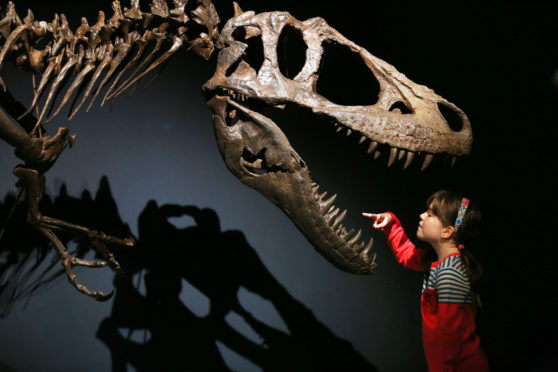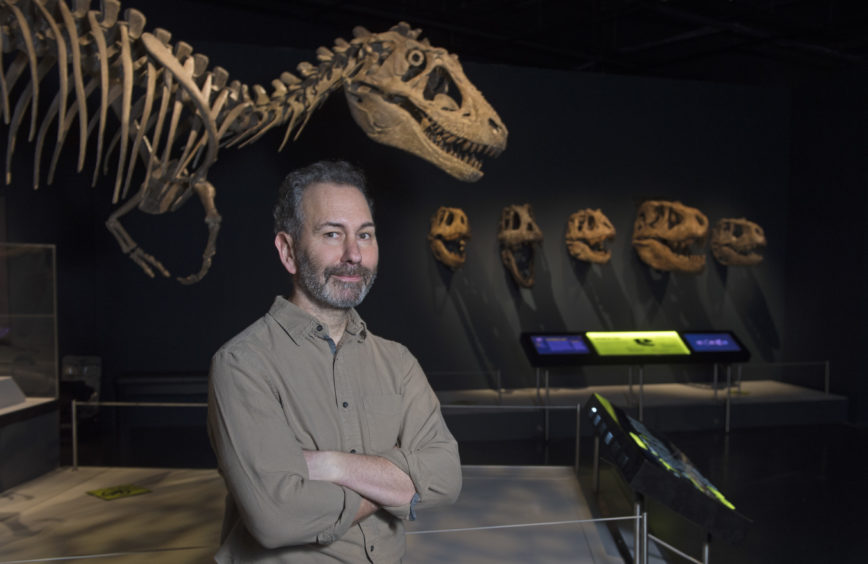
The most comprehensive exhibition on tyrannosaurs is making its only European appearance at the National Museum of Scotland in Edinburgh.
Dr Stig Walsh, a senior curator, told Murray Scougall the Honest Truth about why dinosaurs continue to fascinate.
How did you become interested in dinosaurs?
Perhaps the question should be, how could anyone not become interested in dinosaurs? We tend to become hooked on their size and scariness. As we come to know them better, they almost become friends. That’s what happened to me, and I suspect I am not alone.
Which of your fossil discoveries has been most special?
My special fossil was one descended from a dinosaur that managed to escape the great end-Cretaceous extinction – a bird. I was working in the Atacama Desert in Chile, when I found a place out of the wind to sleep for the night. When I rolled up my sleeping bag the next day, I realised the skeleton of a giant penguin was eroding out of the sand where I had slept. I’d never seen penguin bones so large. That penguin was the first fossil I described as a new species, so it has a special place in my heart.
Why do we remain so fascinated by dinosaurs?
These animals are at once familiar yet alien. There is the sheer size of the bigger beasts, whether T. Rex or the gargantuan plant-eaters. And there is something in the huge span of time – dinosaurs ruled the earth for nearly 200 million years. We can learn all sorts of lessons from dinosaurs to do with evolution, adaptation and extinction.
And what is it about T. Rex?
T. Rex is the iconic dinosaur, the one everyone knows. It was at the top of the food chain and was huge, growing 12-14 metres, weighing up to eight tonnes and with teeth bigger than your hand.
T. Rex was discovered and identified at the start of the 20th Century and the corresponding explosion of popular culture, media, films, books, captured the public imagination.
What can people expect from the new exhibition?
T. Rex lived 66 million years ago – at the end of the time of the dinosaurs. What the exhibition shows is the extended family tree. Tyrannosaurs were around for nearly 100 million years.
You’ll see they varied widely, with small tyrannosaurs, feathered tyrannosaurs from Asia, and some of the large precursors to T. Rex. In all, there are about 25 specimens, as well as rare T. Rex fossil bones. We want people to think of them as living, breathing animals, so there’s a lot of movement, animation and interactivity.
What can you tell us about Scotty, the cast that is the focal point of the Tyrannosaurs exhibition?
Scotty is one of the biggest and most complete T. Rex skeletons discovered to date. Scotty was discovered in 1991 in Saskatchewan, Canada. The story goes that the team completing the excavation there were stuck on what name to give the dinosaur…until later when they were toasting their efforts with a glass of Scotch and settled on Scotty.
Are there dinosaur fossils to be found in Scotland?
Yes. Scotland’s geology gives us a rich history in what we call deep time, ie hundreds of millions of years. Going back before the dinosaurs we see unique evidence in the Borders of some of the first animals to successfully make the transition to land and, yes, real dinosaurs too, with some interesting recent discoveries being made on Skye in particular. Although, to the best of our knowledge, no sign of tyrannosauroids yet.
Do you believe the greatest dinosaur discovery has still to be made?
You need to go some to top Barnum Brown, who discovered the first T. Rex. Then again, there is so much we still don’t know, even about T. Rex. We hope the exhibition will help inspire that same curiosity and excitement we scientists still get from new discoveries today.
The Tyrannosaurs exhibition, supported by the People’s Postcode Lottery, is at the National Museum of Scotland until May 4. nms.ac.uk/tyrannosaurs

Enjoy the convenience of having The Sunday Post delivered as a digital ePaper straight to your smartphone, tablet or computer.
Subscribe for only £5.49 a month and enjoy all the benefits of the printed paper as a digital replica.
Subscribe © Neil Hanna Photography
© Neil Hanna Photography